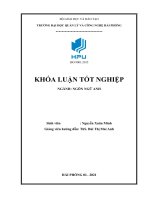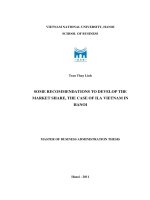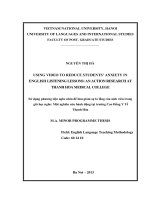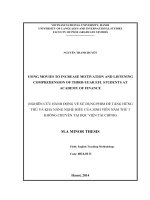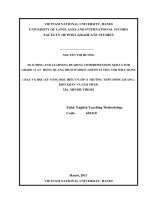Luận văn thạc sĩ using storytelling to develop speaking skills for young learners at an english center in quy nhon
Bạn đang xem bản rút gọn của tài liệu. Xem và tải ngay bản đầy đủ của tài liệu tại đây (736.57 KB, 76 trang )
MINISTRY OF EDUCATION AND TRAINING
QUY NHON UNIVERSITY
PHAN THANH THANG
USING STORYTELLING TO DEVELOP
SPEAKING SKILLS FOR YOUNG LEARNERS AT
AN ENGLISH CENTER IN QUY NHON
Field: Theory and Methodology of English Language Teaching
Code: 8140111
Supervisor: Dr. VO DUY DUC
BỘ GIÁO DỤC VÀ ĐÀO TẠO
TRƢỜNG ĐẠI HỌC QUY NHƠN
PHAN THÀNH THẮNG
SỬ DỤNG KỂ CHUYỆN ĐỂ PHÁT TRIỂN KỸ NĂNG
NÓI CHO HỌC VIÊN NHỎ TUỔI TẠI MỘT
TRUNG TÂM TIẾNG ANH Ở QUY NHƠN
Ngành: Lý luận và phƣơng pháp dạy học bộ môn Tiếng Anh
Mã số : 8140111
Ngƣời hƣớng dẫn: TS. VÕ DUY ĐỨC
i
STATEMENT OF AUTHORSHIP
I certify that this thesis is the result of my own study and that it has not
been submitted to any other university or institution wholly or partially. All
statements of the thesis which are not my own are written in quotation and
can be shown in the list of references.
Quy Nhon, 2022
PHAN THANH THANG
ii
ACKNOWLEDGEMENT
For the completion of this thesis, I have received great assistance and
support from my teachers, colleagues, students and my family.
First of all, I would like to send my deepest thanks to my supervisor,
Dr. Vo Duy Duc, for his encouragement, guidance and his critical comments,
without which I could not have finished my thesis. He also offered me great
help in terms of ideas and materials.
I am also grateful to all lecturers of M.A course at the Department of
Foreign Languages and the Department of Pedagogy in specific and to Quy
Nhon University for their valuable lectures from which I have had such a
great motivation and benefited a lot in the writing of this thesis.
My sincere thanks are due to all the colleagues, and students at
International Active Learning Center (IALC) - an English Center in Quy
Nhon for their cooperation in giving me valuable information.
Last but not least, I am in debt to my beloved family and my wife who
are always by my side with their constant help and spiritual support during
my studying process.
I have made great efforts to complete the study. However, I realize that
this thesis is far from being perfect. To make it better, the author expects any
constructive criticism. At last, the writer hopes that this research paper will be
useful for all.
iii
ABSTRACT
In teaching a language, applying suitable method plays an important
role in the success of the lesson. Using stories for educational purposes is an
effective teaching strategy especially for teaching young learners. This study
aimed at investigating the use of storytelling technique in teaching speaking at
IALC - an English Center from teachers‟ perception and the difficulties they
face. The researcher used qualitative and quantitative research which used
survey questionnaire, interview and observation as instruments. The study
findings showed that teachers have vague understanding about the storytelling
technique and infrequent use of this technique in their teaching. In addition,
all of them say that this technique has many benefits to students and it can
make students happy and easy to understand the lessons. Finally, all of the
teachers find that this technique is difficult to use, needs time and places to be
applied and causes noise. It is recommended that teachers need further
training on the use of this technique because it is an important and effective
technique to get students memorize the lesson and it also attracts students'
attention, and it improves their prediction skills.
iv
TABLE OF CONTENTS
STATEMENT OF AUTHORSHIP ................................................................... i
ABSTRACT ..................................................................................................... iii
TABLE OF CONTENTS ................................................................................. iv
LIST OF TABLES .......................................................................................... vii
LIST OF FIGURES........................................................................................ viii
CHAPTER 1. INTRODUCTION ..................................................................... 1
1.2. Rationale .............................................................................................. 1
1.3. Aims of the Study ................................................................................ 2
1.4. Research questions ............................................................................... 2
1.5. Scope of the study ................................................................................ 3
1.6. Significance of the Study ..................................................................... 3
1.7. Organization of the study ..................................................................... 3
CHAPTER 2. LITERATURE REVIEW .......................................................... 5
2.1. Speaking .............................................................................................. 5
2.1.1. Definitions of speaking skill ......................................................... 5
2.1.2. Speaking teaching techniques ....................................................... 6
2.1.3. Techniques to teach speaking skill to young learners .................. 7
2.2. Storytelling .......................................................................................... 8
2.2.1. Definition Storytelling .................................................................. 8
2.2.2. The Advantages Storytelling ........................................................ 9
2.2.3. Storytelling Techniques .............................................................. 10
2.2.4. Procedures Teaching Speaking with Storytelling Technique ..... 12
2.3. Difficulties Applying Storytelling Technique................................... 13
2.4. Previous Studies ................................................................................ 15
2.5. Summary ........................................................................................... 19
v
CHAPTER 3. RESEARCH DESIGN AND METHODOLOGY ................... 20
3.1. Research Design ................................................................................. 20
3.2. Context Of The Research ................................................................... 21
3.3. Participants ......................................................................................... 23
3.4. Materials ............................................................................................. 23
3.5. Research Instrument ........................................................................... 23
3.5.1. Survey Questionnaire .................................................................. 24
3.5.2. Interview ..................................................................................... 24
3.5.3. Observation ................................................................................. 26
3.6. Data Collection................................................................................... 26
3.7. Data Analysis ..................................................................................... 27
3.7.1. The Questionnaire Data Analysis Procedures ............................ 28
3.7.2. Interview Data Analysis Procedures ........................................... 28
3.7.3. Observation Data Analysis Procedures ...................................... 29
3.8.
Summary ......................................................................................... 29
CHAPTER 4. FINDINGS AND DISCUSSION ............................................ 30
4.1. Questionnaire ..................................................................................... 30
4.1.1. Teachers‟ opinion about speaking skills. .................................... 30
4.1.2. Teachers‟ perception about the use of communicative
activities in teaching speaking skills..................................................... 31
4.1.3. The frequency of using storytelling activities in teaching
speaking ................................................................................................ 32
4.1.4. Teachers‟ role in designing and managing storytelling
activities in classrooms ......................................................................... 33
4.1.5. Teachers‟ implementation of storytelling activities ................... 34
4.1.6. Benefits of use storytelling activities in teaching English
speaking skill to young learner ............................................................. 35
vi
4.1.7. Difficulties the teachers encounter when conducting
storytelling activities in teaching speaking skills ................................. 36
4.2. Interview ............................................................................................ 38
4.2.1. Teachers‟ understanding and practicing storytelling technique . 38
4.2.2. Storytelling is beneficial ............................................................. 39
4.2.3. Teachers‟ Challenges of Using Storytelling ............................... 41
4.3. Observation ........................................................................................ 43
4.4 Chapter Summary ............................................................................... 46
CHAPTER 5. CONCLUSION AND SUGGESTIONS ................................. 47
5.1. Conclusion ......................................................................................... 47
5.1.1. The teachers‟ perceptions of storytelling in a speaking class..... 47
5.1.2 The challenges teachers face in using storytelling to enhance
students speaking skill .......................................................................... 48
5.2. Implications ........................................................................................ 49
5.3. Limitation ........................................................................................... 50
5.4. Suggestions for Further Studies ......................................................... 50
REFERENCES ................................................................................................ 52
APPENDICES
vii
LIST OF TABLES
Table 1: Roles of the teacher during storytelling activities ........................... 33
Table 2: Teachers‟ perception of the aims of storytelling activities .............. 34
Table 3: Teachers‟ ways to promote storytelling activities ........................... 35
viii
LIST OF FIGURES
Figure 4.1.1: Teachers‟ opinion about the speaking skill ............................... 30
Figure 4.1.2: Teachers‟ opinion about teaching speaking skills .................... 31
Figure 4.1.3: Teachers‟ perception about the use of communicative
activities ................................................................................... 31
Figure 4.1.4: The frequency of using storytelling activities teachers in
teaching speaking ..................................................................... 32
Figure 4.1.5: Teachers‟ opinions about the benefits of storytelling
activities ................................................................................... 36
Figure 4.1.6: Teachers‟ difficulties in implementing storytelling activities ... 37
1
CHAPTER 1. INTRODUCTION
1.2. Rationale
The mastery of speaking skills in English is a priority for many second
or foreign language learners and teaching speaking in language classes plays
an important role. When teaching speaking, teachers learn that there are many
challenges to creating a good speaking class. Teachers should think about
whether or not the way they teach speaking is good. Biyem (1997) says that
teachers have a lot of problems when it comes to teaching and learning the
English language. For example, there are not enough classrooms and
educational technology. Moreover Punthumasen (2007) also found that most
students do not want to learn English because they find it boring and the way
it is taught is not interesting. Also, there aren't enough interesting English
textbooks and other materials to get them to study.
When teaching English as a foreign language (EFL), a teacher should set
up a classroom where students can have real-life conversations, do real-life
activities, and do meaningful tasks that help them use oral language. Nunan
(1991) says that teachers should help their students by coming up with ways
to handle all kinds of communication. This will make sure that all students get
the same chances to improve their speaking and listening skills with other
people. The lessons will be more fun if the teachers can come up with fun
activities by using techniques that are right for the level of the students.
These reasons support the idea that language teachers at all levels in IALC
English Center in Quy Nhon should use more interesting activities,
technology, or appropriate methods to improve their teaching.
One way to teach young children English is to use different methods,
such as language games, songs, role-playing, storytelling, etc. The technique
of telling stories has been used a lot in education, and it has helped teach
2
language speaking in many ways. Many researchers around the world (Nunan
1988; Brimful et al. 1991; Ellis and Brewster 1991; Wood 1998; Brewster et
al. 2004; Write 2004; and others) suggest that storytelling is a good and
effective way to improve young learners' skills and interest in English and
help them learn more.
In conclusion, the purpose of this study is to find out more about how
teachers see and understand the role of stories in teaching English to Young
Learners. The other goal of this study is to find out how teachers feel about
using storytelling to teach young students in the classroom. The researcher
hopes that the results of this study will give teachers both theoretical and realworld reasons to use stories to teach young students in the classroom.
Moreover, this research was also conducted to solve the teachers‟ problems in
teaching speaking through storytelling.
Teachers at the IALC English Center in Quy Nhon have been using this
method, but it hasn't worked as well as they hoped. Lessons that teach how to
tell stories aren't part of the curriculum, so they're always taught after school.
There's always not enough time, classrooms, teaching tools, etc. Because of
this, students don't get many chances to practice speaking in a storytelling
classroom, so their speaking skills do not get much better.
1.3. Aims of the Study
The study aims at examining objectives in their speaking classes and
investigating what problems teachers have when using storytelling to teach
speaking.
1.4. Research questions
Based on the objectives stated above, the study aims to answer the
following research questions:
1. What are teachers‟ perceptions of storytelling in a speaking class?
3
2. What are challenges teachers face in using storytelling to enhance
students speaking skill?
1.5. Scope of the study
The study was conducted at IALC – an English center in Quy Nhon.
The research concentrates on the young learners. The participants involved in
the research are students at IALC. This research was conducted at IALC – an
English center in Quy Nhon because this English center uses storytelling as a
method to teach speaking skills to young learners. Therefore, the researcher
wanted to examine the teachers‟ perceptions of storytelling to teach young
learners in classroom and solve the teachers‟ problems in teaching speaking
through storytelling.
1.6. Significance of the Study
This study attempts to describe the teaching of English to young
learners through using storytelling in speaking class at IALC – an English
center in Quy Nhon. The findings of the study contributed a number of strong
points to the center‟s head-office, English teachers and researchers of the
related fields.
The study was also significant for the teachers. It was expected that
the English teachers could have deeper understanding about the technique and
the effectiveness of using storytelling and they would know what they need
supporting. It means that the result of the study can be used as a feedback by
the teacher to improve their teaching.
Finally, the study could give contribution to other researchers as
references in conducting further researcher.
1.7. Organization of the study
This minor thesis is divided into five chapters:
CHAPTER 1: “Introduction” presents rationale, statement of the
4
problem, aims and objectives of the study, research question, the scope of the
study, significance of the study, and the design of the study.
CHAPTER 2: “Literature Review” provides a literature review on
theoretical issues related to speaking and storytelling.
CHAPTER 3: “Methodology” describes an overview on context of
the study, research design, instrument used in the study.
CHAPTER 4:“Data analysis and discussion” results from the
investigation of the factual situation in teaching speaking applying
storytelling technique at IALC – an English center in Quy Nhon.
CHAPTER 5:
accomplishments
and
“Conclusion” provides a summary of the thesis'
recommendations
instructors, and future scholars.
to
education
management,
5
CHAPTER 2. LITERATURE REVIEW
In this chapter, the role of speaking is presented and speaking teaching
techniques and storytelling technique. Toward the end of the chapter, the
difficulties in applying storytelling are given.
2.1. Speaking
2.1.1. Definitions of speaking skill
According to several educators and scholars, communication is a
vital ability for everyday living. Bailey and Savage (1994) underline that
speaking is a fundamental ability that is the result of reading and listening,
and that it is used daily. In a similar vein, Hayride (2006) asserts that speaking
is a critical component of language acquisition since the capacity to
communicate is crucial to students' academic and professional success.
Nunan argues that speaking is equated with oral communication,
which are typical means of conveying information, expressing ideas, and
articulating thoughts Nunan (1991). According to this perspective, it is
evident that speaking is the act of delivering speeches and discussions to
express one's views. In addition, according to Chaney's definition, speaking is
the act of constructing and communicating meaning via the use of verbal and
nonverbal symbols in a variety of circumstances Chaney (1988). From this
perspective, body language can only be used to clearly convey emotion and
opinion while speaking.
In summary, most of these show some common characteristics which
speaking uses the words and produces the sound to express their ideas, feeling,
thought through ordinary voice. Moreover, speaking needs verbal and non-verbal
symbols to express speakers‟ knowledge, opinion in communication.
As result, speakers need to combine various skills in speaking.
6
2.1.2. Speaking teaching techniques
Speaking is the process through which individuals express and
transmit their thoughts to others verbally. Speaking, according to Girt and
Hans in Ferial (2012), is speech or utterances made by the speaker with the
aim of being known, and then the listener analyzes the sayings to determine
the speaker's intention. Speaking, according to Irawati (2014), is the action of
producing sayings in the form of words and phrases verbally in order to
interact with others. Khorashadyzadeh (2014), on the other hand, says that
speaking requires not only an understanding of how to use linguistic skills
like grammar, pronunciation, and vocabulary, but also an understanding of
sociolinguistic skills like when, why, and how to speak. Bahadorfar and
Omidvar (2015), say that a person's speaking skills are good when the listener
can understand what the person is saying.
Also, Ur in Akhyak and Indramawan (2013:20) say that speaking
activities that go well have a few things in common. First, the people learning
the language want to talk as much as they can. Second, everyone who takes
part in the speaking activity gets a chance to talk. Third, the people learning
the language are very motivated and interested in speaking. Finally, the level
of language used is good enough.
Speaking is the way that humans share and talk about information,
ideas, and feelings through spoken language. The goal of speaking is for the
speaker and the listener to talk back and forth with each other. Both the
professors and the students hope that the students will be able to speak
English fluently in class and in the real world. Teaching speaking is what
teachers do to help their students get better at expressing their thoughts,
feelings, and ideas out loud.
7
Speaking is the way that humans share and talk about information,
ideas, and feelings through spoken language. The goal of speaking is for the
speaker and the listener to talk back and forth with each other.
Both the professors and the students hope that the students will be able to
speak English fluently in class and in the real world. Teaching speaking is
what teachers do to help their students get better at expressing their thoughts,
feelings, and ideas out loud.
Students can improve their speaking skills in many ways, such as by
practicing dialogues, playing games, singing songs, telling stories, giving oral
reports, role playing, having small group discussions, giving speeches,
reading the news, reading poetry, and debating. Young people can improve
their speaking skills by listening to and telling stories.
2.1.3. Techniques to teach speaking skill to young learners
Nunan (1991) recommends that learners would be better if they are
given the maximum number of chances to practice the target language in
meaningful situations. Moreover, Nunan (2003) has provided some
suggestions for teaching speaking as below:
Teachers must first arrange their lessons with consideration for the
context variations between two languages and two cultures. He says that
pupils struggle to acquire a foreign language in a variety of circumstances
because they have limited opportunity to apply it outside the classroom.
Therefore, some learners of a foreign language are unable to comprehend or
converse with native speakers in real life.
Secondly,
at
the early and
intermediate levels, it is essential to build fluency and precision. Teachers
should give pupils with opportunities to improve their fluency. It is certainly
true that committing errors is a normal part of learning a new language, yet
accuracy is also the goal of the process.
8
Thirdly, using group or pair work enhances the effectiveness of the
speaking lesson. Activities including pair and group work may improve the
amount of time students speak the target language. In addition, there are
additional opportunities for students to share speaking-relevant information.
Next, teachers should design speaking activities that require
negotiation of meaning via clarification, repetition, or explanation requests.
Teachers should design speaking activities that are appropriate for all levels
of students in the classroom in order to assess their abilities.
Finally, teachers should construct classroom activities that provide
instruction and practice in both transactional speaking (communicating to
complete a task, such as the trade of products) and interactional speaking
(communicating to engage with others).
2.2. Storytelling
2.2.1. Definition Storytelling
Before going to bed, the majority of kids look forward to hearing
bedtime stories from their grandparents or parents. This was back in the days
before the development of television, computers, or the internet. According to
Rubin (1990), storytelling is the "oral interpretation of literature and folklore."
This definition indicates that the narrative, the storyteller, the place, and the
listeners are the elements that make up the medium of storytelling. According
to Harari, the difference between humans and animals is that people are
capable of creating tales that are rich in both imagination and experience
Harari (2014). It is the way that has been used by people throughout their
history and is completely natural to pass on their knowledge from one
generation to the next.
In today's world, writers use a wide range of linguistic devices to
articulate their understanding of the term "storytelling."
9
According to Safdarian (2013), students are considered to be engaging in
storytelling when they repeat tales in their native tongue after listening to the
stories told by the instructor. In a different sense, storytelling is an oral
activity that involves improvisation in the telling of a story, facial gestures,
and body movement. This type of storytelling is used to grab the attention of
audiences by utilizing multi-sensory techniques that stir the emotion
associated with an event in a story Stanley and Dillingham (2009). In
addition, Champion, who is referenced in Irawati (2003), elucidates that
storytelling is an oral activity in which words and gestures may be employed
in a colorful manner to construct scenes in a sequence. This idea is presented
in the context of storytelling.
All of the information shown up to this point suggests that telling
stories orally involves arranging imaginative situations in a progression that
stimulates children's imaginations, helps them acquire languages, and
motivates them.
2.2.2. The Advantages Storytelling
According to the findings of a large number of academics, telling
tales has a variety of benefits, including those related to language
development, creativity, and motivation. The importance of storytelling in the
development of one's imagination is emphasized by Ellis and Brewster
(2002). Children get more emotionally invested in a narrative when they are
able to recognize themselves in the artwork and characters. Their creative
ability is enhanced by the experience of using their imagination. Storytelling
is another effective method for connecting a child's actual environment with
his or her fantasies and imagination. According to Hayriye (2006), creating
stories allows students to convey their thoughts freely and imaginatively
without having to worry about whether or not they have reached the
appropriate conclusion.
10
Children are better able to grasp the contents of the tales and recall
what occurred in the stories when they are exposed to spontaneous recurrence
of essential vocabulary and phrases found in stories. As a result, the use of
tales may facilitate the development of language acquisition within the
environment Ellis&Brewster (2002). In addition to this, Ellis and Brewster
highlight the fact that tales may bridge the gap between language study and
language usage and also connect classroom learning with the world outside of
the classroom. Some of the activities may not necessarily have a very strong
aspect of language, but they are still significant in generating the impression
among the students that studying English means having fun, being active,
being creative, and having pleasure Ellisand Brewster (1991:1).
According to Stockdale's (1995) theory, the art of storytelling boosts
learner motivation because it has the ability to thoroughly captivate students
via its unique blend of educational value and entertaining content. According
to Krashen (1981), it is easier for students to be successful in the acquisition
of a second language if they have high levels of motivation, self-confidence, a
positive self-image, and a low degree of anxiety. The transmission of pictures,
ideas, and emotions that inspire students to learn a language may be
accomplished via the use of storytelling, which, as a result of these
advantages, helps students strengthen their speaking abilities.
2.2.3. Storytelling Techniques
The education system relies heavily on its instructors to impart
knowledge and foster student growth. They have a significant obligation to
impart their expertise and information onto the pupils, to direct students in the
process of intellectual growth, and to instruct pupils in the methods necessary
to assimilate, evaluate, and broaden their own specific knowledge and
capabilities.
11
Before they can begin sharing tales with pupils, instructors must, first
and foremost, prepare themselves. The best way for educators to prepare for
their role as storytellers is to get acquainted with the books and artwork in
them by determining in advance which drawings or elements they will
highlight. It is important for instructors to pay close attention to the recording
of the tale in order to build their self-assurance. It is important for educators
to read a narrative several times until they feel comfortable with it and are
able to explain it in an adequate manner Ellis& Brewster (2002).
In addition, in order to achieve these goals, it is necessary to have
strategies for teaching public speaking via the use of narrative. Some of the
following strategies were recommended by Zaro and Salaberri (1995:5):
i.
Firstly, instructors should recognize that narrative may generates
curiosity since it awakens students‟ imagination and interest in
language proficiency.
ii.
Secondly, while demonstrating a narrative, the instructor should allow
students to experience the target language and encourage their
cooperation.
iii.
Next, educators may utilize their native language, voice, facial emotions,
and hand gestures to reinforce the tale as appropriate. Ellis and Brewster
(2002) concur that instructors should establish an environment for
storytelling in which both the teacher's face and the visuals are visible to
students. Teachers employ gesture, mime, facial expression, and a range
of tempos and tones to transmit meaning and maintain students'
attention. Richard-Amato (2003) adds that if a pupil tells a story without
emotion, feeling, or bodily engagement, it may be useless.
Finally, narrative should be lighthearted and casual.
In addition, Brewster, Ellis, and Giard (2004) suggest the following
approaches for incorporating narrative into the classroom:
12
a) Teachers could begin with a brief session with modest criteria if their
pupils are unfamiliar with storytelling.
b) Teachers should present a narrative slowly and clearly so that kids have
time to detect sounds and words, match what they hear to what they see
in the visuals, ponder, ask questions, and provide feedback.
c) Teachers should remark on the artwork and direct students' focus in
order to capture their attention.
d) Teachers could encourage children to participate in the retelling of a
narrative by having them repeat essential vocabulary terms and phrases.
e) Teachers should employ a variety of gestures, mimes, facial
expressions, voice projection, and pauses to communicate meaning and
inspire children to narrate tales.
f) Teachers should ask students questions while relating a narrative in
order to encourage interaction between students and the tale.
g) The instructors generate opportunities for the pupils to expose
themselves to language and give them chances to figure out the
meaning and retain it by repeatedly telling the tale Brewster et al.
(2004:21)
In conclusion, the function of the teacher as a storyteller who has a voice that
is both natural and appealing will be very important. In order to capture the
attention of the pupils, the teacher simplifies the narrative while maintaining
an animated facial expression.
2.2.4. Procedures Teaching Speaking with Storytelling Technique
Many researchers around the world (Scott 1985; Brewster, Ellis, and
Girard 2004; Samantaray 2014; Fikriah 2016) have suggested ways for
teachers to use storytelling to teach speaking in their own way.
The researcher synthesize the most common procedures based on the
13
collected information:
(1) The teacher divides class into some groups, each group includes 56 students, and the number of group depends on the number of students in the
class.
(2) The teacher gives different written stories for groups to choose.
(3) The teacher asks every group take a paper from the white board
(4) The teacher asks them to develop a story in 15 - 20 minutes
(5) The teacher asks them to retell their story based on the group
discussion
(6) The teacher gives award to the group considered as the best group.
2.3. Difficulties Applying Storytelling Technique
Even though the storytelling method in the classroom has a lot of
benefits, some teachers experience certain difficulties in applying it.
The lack of adequate supplies and pedagogical aids in the classroom
presents the first issue with the use of storytelling in the classroom. According
to Biyaem (1997), it is difficult for instructors to teach and master the English
language due to issues such as classrooms that are not well-equipped and a
lack of educational technology. Additionally, there is an insufficient quantity
of English textbooks and other resources that are attractive enough to
motivate children to learn. Technology may be an effective tool for teaching
pupils how to communicate with one another, but it cannot take the place of a
qualified language instructor, as Prapphal (2003) points out.
The second obstacle faced by teachers is the psychology of the
learners. Because of the ways in which the students' mother tongues influence
their English, particularly in the way that they articulate words, the students
report that they do not feel comfortable speaking English with their instructor
and classmates. They also do not have sufficient opportunities to use English
in their day-to-day lives. According to research done by Jaiyai, Torwong,
14
Usaha, Danvirattana, Luangthongkam, and Piyadamrongchai (2005), a
significant number of students lacked the ability to effectively apply their
English abilities, particularly in the areas of hearing and speaking. In addition,
Punthumasen (2007) discover that the majority of students do not have an
interest in learning English since both the subject matter itself and the manner
in which it is presented in the classroom are boring.
The next problem is running out of ideas. Most of the time, teachers
tell stories with the same idea in mind. Setyariny (2011) also says that the
stories that are already on the market are limited and not good enough for
teaching, so teachers have to make their own.
In addition, the adoption of this strategy is often overlooked by
educators because of challenges such as distracting background noise in the
classroom and a shortage of available class time. According to Awed
Sulaiman Keshta (2013), the fact that storytelling has not been the primary
teaching method and that lessons using storytelling are not included in the
students' curriculum is one of the challenges that teachers face when
attempting to implement the storytelling method in their teaching. As a result,
there is not enough time to concentrate on developing the narrative approach.
In Quy Nhon city, where we were born and raised, when educators
employ the narrative approach as a method in speaking classrooms, they also
confront certain challenges. The majority of instructors we spoke to agreed
that the textbook that is used to teach English in schools is not very useful. It
ignored one of the most crucial aspects of language: the ability to
communicate orally. Since there is no speaking exam included in the
curriculum, the instructors have little choice but to focus primarily on
grammar as the most important component of learning English and have
disregarded other activities that may be done in the classroom.
Students, in point of fact, do not feel at ease participating in speaking lessons
15
because they lack the confidence to articulate their thoughts and are fearful of
making grammatical errors when speaking. When attempting to use this
strategy, educators often face challenging obstacles, such as a lack of
available time or distracting background noise in the classroom. It's possible
that this is due to a lack of familiarity with or experience with the approach in
question. These factors lend credence to the notion that language instructors at
the IALC English center, regardless of the level of their students, ought to
incorporate into their lessons a greater number of engaging activities, forms of
technology, web-based projects, online self-evaluations, and electronic
portfolios.
2.4. Previous Studies
In King's (2007) view, tales are important resources for the
development of imagination and creativity, as well as for gaining knowledge
and providing consolation. In this piece of writing, King discussed her own
experiences as well as her use of the collaborative story creating process with
students of all ages and adults working in a variety of educational settings.
According to what the author mentioned, the process of generating
collaborative tales provided numerous chances for students to produce
beautiful stories based on stories, utilizing image creation and abstract
prompts as inspiration. She said that the iterative process enables children to
enhance both their speech and written expressiveness as well as their
vocabulary. King extended an invitation to other educators, urging them to
incorporate collaborative story making into their repertoire of teaching
strategies in order to improve not only their own reading, writing, speaking,
and listening abilities but also to foster a community of learners who are
supportive of one another.
Poveda and Cuevas (2008) stated that teaching story-telling to children

